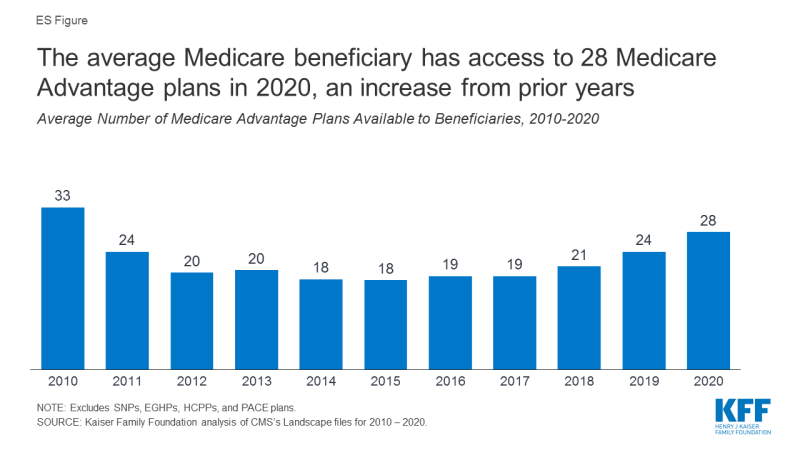Medicare Advantage 2020 Spotlight: First Look
Medicare Advantage plans have taken a large and growing role in the Medicare program over the past decade, with more than 22 million Medicare beneficiaries (34%) enrolled in Medicare Advantage plans in 2019, a private plan alternative to the traditional Medicare program. This brief provides an overview of the Medicare Advantage plans that will be available for 2020, based on an analysis of data from the Centers for Medicare and Medicaid Services (CMS). Findings include:
- Number of Plans. Nationwide, 3,148 Medicare Advantage plans will be available for individual enrollment for the 2020 plan year – an increase of 414 plans since 2019. The average beneficiary will be able to choose among 28 plans in 2020, up from 24 in 2019 (ES Figure). The number of Special Needs Plans (SNPs) will also increase from 717 plans in 2019 to 855 plans in 2020.

Figure 1: The average Medicare beneficiary has access to 28 Medicare Advantage plans in 2020, an increase from prior years
- Variation in Number of Plans. The number of Medicare Advantage plans will vary greatly across counties in 2020, from 31 plans, on average, in metropolitan counties to 16 plans, on average, in non-metropolitan counties. More than 60 plans will be available in six counties (in OH and PA), while no plans will be offered in 77 counties (accounting for less than 1% of beneficiaries) in 2020.
- Number of Firms. The average beneficiary will be able to choose from plans offered by seven firms in 2020, similar to 2019. Four percent of all Medicare beneficiaries will have a choice of plans offered by two or fewer firms while 24 percent will be able to choose from plans offered by 10 or more firms.
- Market Entrants and Exits. Thirteen insurers will be entering the Medicare Advantage market for the first time, and one insurer will be exiting in 2020. In all, well over 100 firms will offer Medicare Advantage plans in 2020.
- Extra Benefits. Nearly all beneficiaries (97%) have access to a Medicare Advantage plan that provides dental, fitness, vision, and hearing benefits, which are not covered by traditional Medicare. Many beneficiaries also have access to some transportation assistance (92%) and a meal benefit (96%), but some benefits are less frequently available, such as in-home support (54%), bathroom safety (49%), telemonitoring services (29%), and support for caregivers of enrollees (12%).
